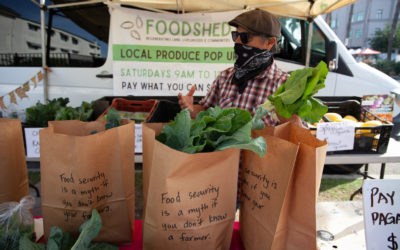Becoming a subscriber to Foodshed’s Fresh 5 program—a weekly distribution of fresh, seasonal produce, grown by the small farmers who make up the Foodshed cooperative—means you’re in for two surprises with every delivery. One is the produce itself: an ever-changing...

Moving Barricades to Keep Farmers Farming
As a lifelong farmers market fan turned operator, I like to say that my job is weird. My team and I run grocery stores in the street. We move barricades, tow cars, curate vendors, create marketing magic, and monitor and shape regulations. And that’s just the tip of the iceberg (although we prefer Red Leaf).
We see our role, as market operators, to keep farmers farming and maintain the security provided by the short chain of our local food system.
At the most basic level, farmers markets provide communities with better-tasting, nutrient-dense food, which increases the overall health of a community. Farmers markets bring small farmers and foodmakers face-to-face with consumers, maintaining the local food supply. Dollars spent at local markets stay in the community, providing employment and supporting other local businesses. Community members gain a deeper knowledge of their food systems, food preparation methods, and seasonality.
The returns that farmers, fishermen, and food makers experience on their labors can be four or five times as great when shoppers purchase directly from producers. Buy an avocado for a dollar at a farmers market and the farmer keeps somewhere between 92 cents and the full dollar (depending on market rent structure). Spend the same amount for that fruit at a big grocery store or from a distributor and the farmer may keep only 20 cents or less of wholesale income. Fishermen and foodmakers gain significant economic advantages from keeping the retail price of what they produce, enabling them to keep providing the community with fresh food while supporting their families.
Unfortunately, what seems like a perfect model of passion-meets-profit—not to mention health and sustainability—is riddled with challenges.
Balancing equitable access to fresh food with financial sustainability for small farmers is an ongoing challenge. We strive to bring markets to the many communities that want them, keep fresh food affordable, and at the same time let farmers recoup the real cost of the healthy food they produce.
The costs of liability insurance for market organizers and participants, ever-increasing regulatory requirements, and the cost of monitoring compliance can also seem overwhelming.
Finally, there’s a farm labor shortage. The field is shrinking, because many know that building equity and providing for a family on a farmers’ or farmworkers’ income is incredibly challenging.
Some solutions are well within reach: Insurance indemnity from local cities and counties for certified farmers’ markets would allow the expansion of farmers’ markets into more neighborhoods. On the policy side, zoning changes that would allow large farms to more easily be subdivided into smaller farms for new farmers—keeping strict agricultural use as a requirement—would avoid the current trend of retiring farmers’ land going to housing developers. A proactive local agricultural land trust would also provide preservation of land as working farms. Water policy that prioritizes agriculture over recreation would keep water affordable for farmers.
As eaters, greater awareness of and support for farmers markets as a primary source of groceries would increase sales, thus increasing growers’ income, which ultimately keeps farmers farming and allow others to go into the profession and stay viable.
Each week, I move those barricades in the street and sort through regulations because I want to ensure that my grandchildren and their grandchildren will continue to have access to fresh, unprocessed food. That’s what inspires me.
Everyone who makes the small investment of time to make their local farmers’ market a primary source of their weekly groceries will see an instant return in better tasting food, good health, and a stronger community. Each of us holds the power to make our region and our world better.
Catt Fields White is the founder and CEO of Farmers Market Pros, and Director of San Diego Markets. Catt is committed to making the journey easier for small farmers, food makers, and markets to thrive, through advocacy, education and technical assistance.





